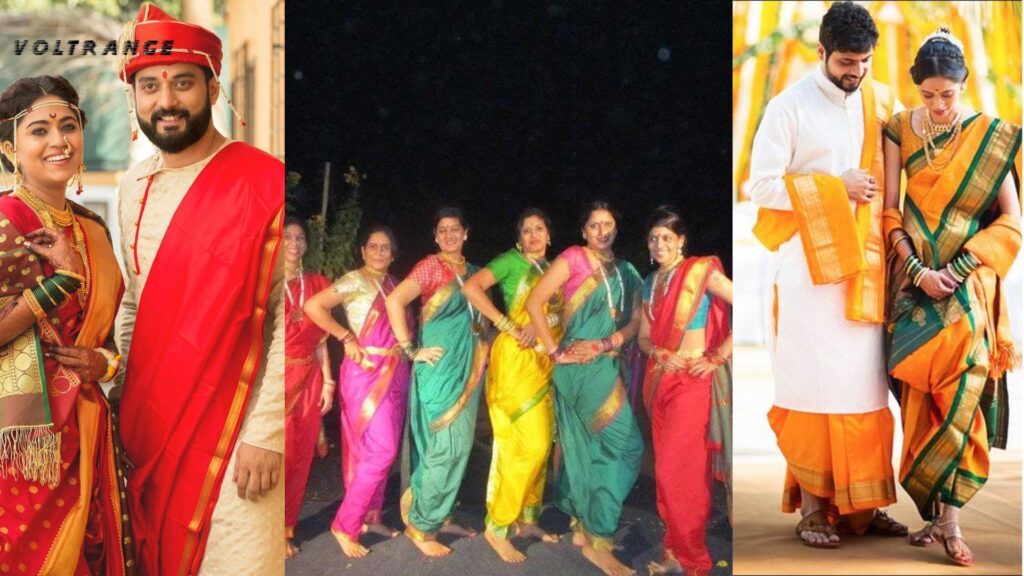
Traditional Dress of Maharashtra
Have you ever thought about the traditional attire of Maharashtra? The rich heritage of Maharashtra is not just reflected in its vibrant folk music, literature, cuisine, or the lively lezim dance, but also in the traditional clothing worn by its people. The attire of both men and women in Maharashtra is practical and well-suited for the state’s agricultural lifestyle, particularly along the Konkan coast. The clothes they wear help them stay comfortable and allow them to work efficiently on farms. Let’s take a closer look at the traditional dress of Maharashtra for both men and women.
Traditional Dress of Maharashtra for Men
1. Dhoti-Kurta with Feta (Turban)
Men in Maharashtra commonly wear a dhoti and kurta as part of their traditional attire. The dhoti is a long piece of cloth tied around the waist, with five knots on each side. The remaining loose fabric is tucked at the back. Dhoti colors are usually white or saffron and are often reserved for special occasions or religious ceremonies.
As for the kurta, it is a short, cotton top worn over the dhoti. Cotton is preferred due to Maharashtra’s hot and humid climate, as it absorbs sweat and keeps the wearer cool. The kurta, mostly in white, creates a classic and stylish look when paired with the dhoti.
A pheta, or turban, is another essential part of men’s traditional dress. This light-colored headgear shields men from the intense heat and is typically worn at special events like weddings, festivals, and religious rituals. More than just functional, the pheta symbolizes pride, respect, and honor.
2. Bandi
A bandi is a sleeveless waistcoat worn over the kurta, adding a formal touch to the traditional attire. Made from cotton to suit the warm climate, bandis offer a more modern, yet still traditional, look, especially during festivals and celebrations.
Traditional Dress of Maharashtra for Women
1. Sarees
For women, the traditional Maharashtrian saree is a 9-yard-long drape, also called a Nauvari. The unique draping style provides freedom of movement and comfort, with the lower part tucked like a dhoti. One of the most famous sarees is the Paithani, originating from Aurangabad. These handwoven silk sarees come in vibrant colors with intricate designs, symbolizing elegance and tradition.
Other notable sarees include Peshwai Sarees, known for their regal patterns and fascinating borders, a nod to the Maratha heritage. Karvat Kathi Sarees, with their flora and fauna-inspired borders, are admired for their beauty and elegance, making them another beloved choice among traditional sarees.
2. Ghagra and Choli
A ghagra is a long flowing skirt worn with a choli (a short-sleeved blouse) and often paired with a dupatta. This combination is a traditional festive or bridal outfit. Cholis, matched with half-draped sarees, add to the beauty of the ensemble, particularly when they come in striking colors like red or green.
3. Himroo and Mashru Traditional Attires
Himroo and Mashru are traditional fabrics from Aurangabad, known for their luxurious feel and stunning textures. Himroo is often used in shawls and sarees, while Mashru is a blend of silk and cotton, offering a shiny, smooth finish that’s perfect for special occasions.
4. Footwear
One cannot mention Maharashtra’s traditional attire without highlighting the Kolhapuri chappals. Made in the Kolhapur District, these sandals are renowned for their durability and longevity. While cotton Kolhapuris are suitable for everyday use, silk versions are more expensive and often reserved for weddings or other significant events.
5. Jewellery
Jewelry plays a vital role in completing the traditional look. The Nath, a unique nose ornament made from gold, is a classic accessory paired with a Nauvari saree. Married women in Maharashtra often wear green bangles, along with gold or silver necklaces, and a Nath, symbolizing marital prosperity. Silver toe rings are also commonly worn, believed to enhance fertility and promote good health.
Conclusion
Despite the rise of urbanization and the influence of Western fashion, the traditional attire of Maharashtra still holds cultural significance, especially in rural and tribal areas. While modern fashion trends continue to evolve, it is essential to preserve the legacy of Maharashtra’s traditional clothing, ensuring that the beauty and practicality of these outfits are not lost in the fast-paced world of today. Even with changing times, many still embrace these traditional garments for their comfort, functionality, and deep-rooted cultural connections.





More Stories
which of the following statements is true about education and lifetime earnings? Complete Guide Here
Statekaidz.com: Education with Fun For Kids 2025
Top 5 Richest States in India by GDP